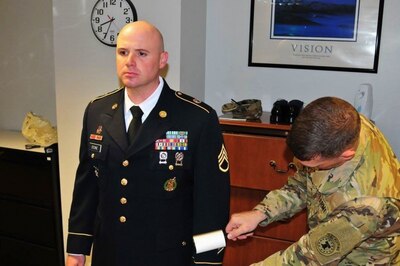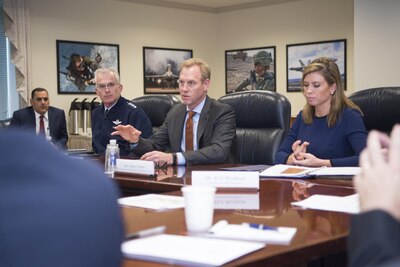By Alun Thomas, U.S. Army Recruiting Battalion Phoenix
RIO RANCHO, N.M., Nov. 9, 2017 — There’s a credo Army Staff
Sgt. Michael Stone lives by -- always try your hardest to the best of your
abilities.
In 2017, Stone has lived up to his personal creed by
pursuing and achieving excellence at the highest levels in U.S. Army Recruiting
Command.
Stone, the center leader for the Rio Rancho Recruiting
Center, Albuquerque Recruiting Company, New Mexico, finished as runner-up in
the USAREC Center Leader of the Year competition. This year he also was the
distinguished honor graduate in his senior leader course and was inducted into
the Sgt. Audie Murphy Club.
Leadership Competitions
Stone’s eventful year began with various center leader
competitions, which he won at the battalion level in Phoenix, before winning
the 5th Recruiting Brigade portion, allowing him to compete nationally at
USAREC in April.
“I had to really push myself at every competition. At the
brigade event I was competing against the best center leaders in the brigade
and it was extremely competitive,” he said. “I managed to win though and went
on to USAREC, which was even more challenging.”
Stone went through a series of events at the culminating
USAREC center leader competition, with a ruck march, weapons qualification, a
written essay, an Army Physical Fitness Test and a board appearance, all
components of the event.
“It was hard … I was competing against the best of the best
and ended up finishing second,” he said. “The soldier who beat me was from
special operations recruiting. We were clearing houses, performing battle
drills, medical lanes, call for fire lanes … I felt I held my own considering
the quality of the competitors.”
Despite finishing runner-up, Stone said he gained an immense
feeling of satisfaction and pride at his performance, helping showcase himself
and the Phoenix Recruiting Battalion.
“I wanted to go up there and represent my battalion and
brigade to the best of my abilities. That’s how I approach everything in my
life,” he said. “I don’t consider it competing against other people. Instead, I
think of it as competing against myself and being the best I can be.”
Striving to be the Best
Stone added, “Sometimes you succeed and sometimes your best
isn’t enough, but at least you’re happy with your results because you’re doing
the best you can.”
Following the competition, he attended his senior leader
course at Fort Knox, Kentucky, in August, where he attained tremendous results
among his class of 62 noncommissioned officers in the recruiting field.
“I had tough competition in my class, but I had the top
[Army Physical Fitness Test] score and the highest grade point average, which
got me the distinguished honor graduate award,” Stone said. “I was also
nominated as the distinguished leader by my peers.”
But the icing on the cake was competing to become part of
the hallowed Sgt. Audie Murphy Club, an honor bestowed on a select few NCO’s.
“The week after graduating SLC I went straight into the
USAREC Audie Murphy competition,” Stone explained. “I’d already been through
the brigade Audie Murphy board, which was a grueling 90 minutes of sitting in
front of the battalion sergeants major and being asked different questions. So
I was prepared.”
In addition to the board appearance, he took another APFT,
wrote a 1,000-word essay and performed a written examination on various Army
subjects.
This allowed Stone to reach the final USAREC level, which
was similar to the brigade event, but one he was prepared for.
“When you get to USAREC Audie Murphy, you’ve been nominated
based on who you are and what you do on an everyday basis,” he said. “The way I
view the Audie Murphy club is: I’m there because of what I do day in and day
out, because you’re not competing against anyone to win.”
Being inducted into the club was the result of extensive
research and training for the board, Stone said, which was intense and demanding.
“The preparation was no joke. Not only was I learning every
Army skill, but every subject and regulation possible,” he explained. “You’re
also learning the Army Creed, Army Song, the NCO Creed … and on top of that is
Audie Murphy’s history, which is very long.”
The hard work was validated when he was inducted, which
Stone said was both a proud and humbling moment.
“To be recognized like that into a club that’s so
prestigious was a proud moment and one I hope can motivate other NCO’s to do
the same,” he said.
Stone said his motivation for achieving his successes comes
from always pushing himself to do his best.
“I try to do everything to the best of my ability. And to
set yourself apart, you have to be willing to do things other people aren’t
willing to do,” he said. “You’ve got to go above and beyond. So the way I look
at it, no matter where I am or what position I’m going to be in, I’m going to
do everything to reach my potential.”










